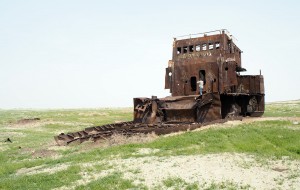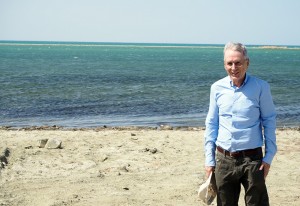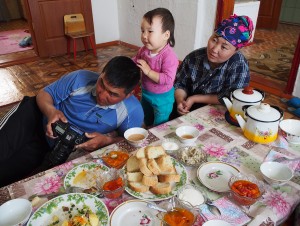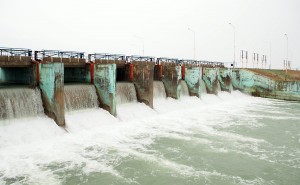Yesterday, upon the steppes, I saw a sea which wasn’t there…
 The Aral Sea ship graveyard near Zhalanash used to host a dozen beached fishing trawlers. They had fled from the port of Aralsk as the sea dried up, but then, with nowhere else to flee, had been abandoned at Zhalanash. Most of the ships have long since been broken up and taken for scrap, but there are still the partial remains of one larger ship and two small ones. All the hulls and most of the deck have been removed, but the decayed superstructures are largely intact. The larger ship in particular is quite striking and I clambered cautiously up to the rotten higher deck and the bridge. Although the ships are just skeletons they are great fun to see; suitably eerie and alien on the dry salty sea bed, which is covered with sand, grass and small sea shells.
The Aral Sea ship graveyard near Zhalanash used to host a dozen beached fishing trawlers. They had fled from the port of Aralsk as the sea dried up, but then, with nowhere else to flee, had been abandoned at Zhalanash. Most of the ships have long since been broken up and taken for scrap, but there are still the partial remains of one larger ship and two small ones. All the hulls and most of the deck have been removed, but the decayed superstructures are largely intact. The larger ship in particular is quite striking and I clambered cautiously up to the rotten higher deck and the bridge. Although the ships are just skeletons they are great fun to see; suitably eerie and alien on the dry salty sea bed, which is covered with sand, grass and small sea shells.
 This is in Kazakhstan, at the Northern end of the Aral Sea. The Southern end of the sea is dying, but while the Northern section of the sea is still much lower than in the past, its level has been stabilized and has even partially recovered due to the Kok-Aral Dam, which keeps the Northern water boxed in to a small manageable area. Freshwater fish have now returned and displaced the saltwater flounders, and there is even hope that sturgeon may return.
This is in Kazakhstan, at the Northern end of the Aral Sea. The Southern end of the sea is dying, but while the Northern section of the sea is still much lower than in the past, its level has been stabilized and has even partially recovered due to the Kok-Aral Dam, which keeps the Northern water boxed in to a small manageable area. Freshwater fish have now returned and displaced the saltwater flounders, and there is even hope that sturgeon may return.
 After visiting the sea itself, we stopped at the nearby village of Tastubek, which lives by fishing and livestock farming. My guide, Serik from Aral Tenizi, had arranged lunch with a Kazakh family. This was fun. The young wife had prepared a fine meal, with a tasty dish of horsemeat and potatoes; good bread; apricots in syrup; and much else. I enjoyed a cup of shumat, fermented camel milk, which tastes like a very sour and slightly bitter yoghurt. Half way through, the husband returned and struck up a conversation in mixed Turkish/Kazakh with a Turkish visitor. I was amused when a Turkish suggestion of “… Instagram?” was rebuked with a vigorous Kazakh assertion of “ … Whatsapp!”.
After visiting the sea itself, we stopped at the nearby village of Tastubek, which lives by fishing and livestock farming. My guide, Serik from Aral Tenizi, had arranged lunch with a Kazakh family. This was fun. The young wife had prepared a fine meal, with a tasty dish of horsemeat and potatoes; good bread; apricots in syrup; and much else. I enjoyed a cup of shumat, fermented camel milk, which tastes like a very sour and slightly bitter yoghurt. Half way through, the husband returned and struck up a conversation in mixed Turkish/Kazakh with a Turkish visitor. I was amused when a Turkish suggestion of “… Instagram?” was rebuked with a vigorous Kazakh assertion of “ … Whatsapp!”.
 The next day we drove to visit the Kok-Aral Dam. Visually this is very tame, merely a low ridge on a concrete core. We stopped at a large set of sluice gates, currently open, which allow excess water to drain South. By allowing fresh water to enter the Northern sea from the Syr Darya (Jaxartes) River while sending overflows of mixed semi-salty water to exit South, the wise Kazakhs are also freshening the Northern section. Unfortunately none of the exiting water makes it to Uzbekistan or the Southern section of the sea. It all dries up within 70km at most. There is a plan to raise the height of the dam, thus expanding the stabilized Northern area, with work planned to start next year. So the Aral Sea may yet return to Zhalanash and its beached ships, and to the currently high-and-dry fishing port of Aralsk!
The next day we drove to visit the Kok-Aral Dam. Visually this is very tame, merely a low ridge on a concrete core. We stopped at a large set of sluice gates, currently open, which allow excess water to drain South. By allowing fresh water to enter the Northern sea from the Syr Darya (Jaxartes) River while sending overflows of mixed semi-salty water to exit South, the wise Kazakhs are also freshening the Northern section. Unfortunately none of the exiting water makes it to Uzbekistan or the Southern section of the sea. It all dries up within 70km at most. There is a plan to raise the height of the dam, thus expanding the stabilized Northern area, with work planned to start next year. So the Aral Sea may yet return to Zhalanash and its beached ships, and to the currently high-and-dry fishing port of Aralsk!